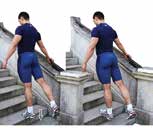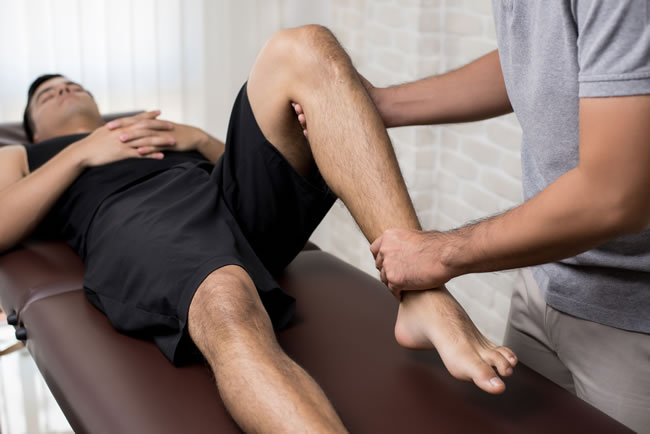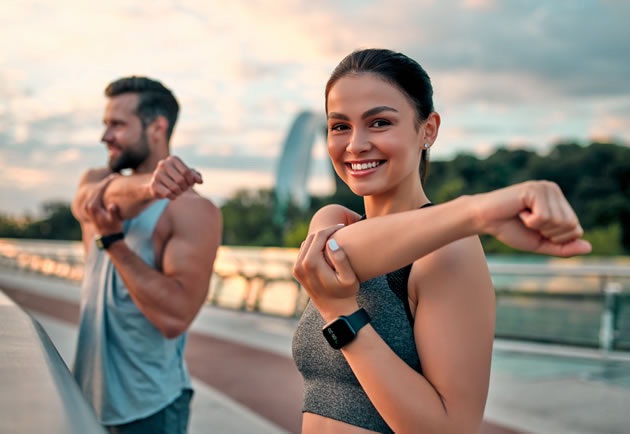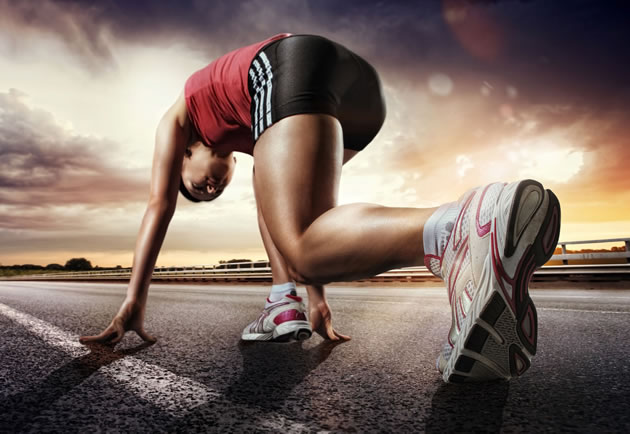ACHILLES TENDINOPATHY INJURIES IN RUNNERS
THE INJURY
The Achilles tendon and plantar fascia are energy-absorbing and energy-releasing structures that are working throughout each stride. They absorb the load as your foot impacts the ground (loads are often 3 times your body weight) and convert the energy to propel yourself during the push-off phase of a stride (where forces are as high as 7 times your body weight).
The Achilles tendon and calf muscle are therefore an essential unit, critical for efficient and effective running. The Achilles tendon is prone to overuse purely by the nature of its function. Pain occurs because of weakness or dysfunction in the tendon rather than what was previously thought to be an inflammatory reaction. This can be a challenging area to treat due to the tendon’s poor perfusion (blood flow), which may need longer recovery periods, so it’s best to tackle this injury at the earliest point possible.
THE SYMPTOMS
- Pain close to the heel, which is often sharp, poking and incapacitating.
- Pain along the Achilles tendon, at the back of the lower leg.
- Occasionally there can be mild swelling at the base of the tendon (near the heel) and redness.
- If you pinch the Achilles and it’s very sore, then the source of the problem is likely to be the tendon.
- Pain during and after running (Stop! This is not an injury you can run through)
- In chronic cases, there can be thickening or a thickened ‘lump’ along the tendon, especially when compared to the uninjured leg.
THE CAUSE
The Achilles tendon is the extension of the calf muscles, gastrocnemius and soleus, where it attaches to the back of the heel and is responsible for plantarflexion (pointing your toes). Sometimes excessively tight, weak calves are the culprit. Tight lower legs put added strain on the Achilles tendon, and over the course of many months of hard training, this overuse injury can develop. A weak posterior chain (the muscles that work together along the back of your body including the back extensors, gluteus muscles, hamstrings, calves) can also be a cause of Achilles tendinopathy. Constantly running on hard surfaces like concrete or asphalt can contribute to developing Achilles tendinopathy as the loads absorbed by the tendon are greater than running on grass or dirt roads.
Unsupportive footwear can overburden the Achilles tendon with time, as it must work even harder to control ankle movement whilst running. Worn out shoes or shoes with inadequate cushioning can exacerbate Achilles tendon issues as they add no benefit in absorbing load during heel strike. Rapid increase in volume and/or intensity or training can have the same effect much more quickly, so it’s important to pay attention to both your feet and your sessions—especially when you’re training hard. Severe pronation, foot instability, a leg- length discrepancy and muscle asymmetries can also contribute to Achilles pain.
THE FIX
Rest, icing, and strapping can relieve symptoms in the early/acute stages. Reducing training intensity and volume may be required, possibly even complete rest for a few weeks depending on pain and the severity of the injury. The earlier you get treatment the shorter your time off running in the ‘long run’. Soft tissue massage can be used to release tight structures throughout the lower limb and back. Physical therapy treatment will mobilise tight structures, possibly use acupuncture and prescribe rehab exercises
to strengthen your calves, hamstrings, glutes and core.
Stretching is also a key component to rehab. Eccentric heel drop exercises (lengthening under load), taught by your physical therapist, will be an essential part of your recovery. Advice about your shoes, orthotics and running technique can help. Importantly, keep an eye on your training. Don’t do too much, or go too hard, too quickly.
THE PREVENTION
When people experience Achilles tendinopathy, it often starts as a simple feeling of stiffness in the tendon. If you take steps to increase flexibility, strengthen the ankle and calf muscles and decrease stress on the tendon at the first sign of stiffness, it’s possible to prevent the problem from escalating.
One of the easiest ways to prevent Achilles tendinopathy is to keep the tendon strong and flexible. Regular strengthening of the calf, especially eccentric exercises will be beneficial, along with a regular stretching programme. It is important to strengthen the entire limb from the pelvis, core, hip, gluteus muscles and hamstrings as these will all ensure the entire kinematic chain is working efficiently and minimising overload of the Achilles tendon. Then address any underlying risk factors (like shoes, orthotics) and finally a key prevention strategy is monitoring your training capacity. Slow and steady wins the race!
ACHILLES TENDINOPATHY REHABILITATION
YOUR REHABILITATION PROGRAMME
This programme has specific exercises for Achilles Tendinopathy. Remember the key is to strengthen the calf muscle and tendon eccentrically, whilst maintaining good flexibility; and don’t forget the rest of your leg! It is important to ensure the exercises are performed with good technique and good postural control. Make sure to repeat the same number of exercises on both legs. Make sure you are always pain-free and take care not to progress too quickly. We have given suggested sets and repetitions, and the exercise routine should be performed twice a day. Remember everyone is different so your therapist may give guidance that is more specific to you.
WARM UP AND COOL DOWN
If muscles are tight, weak or injured, it is particularly important to warm up (unless advised otherwise by your practitioner) with a brisk walk or a gentle jog at a pain-free pace for 5 minutes before you start your
exercises. This increases your circulation and helps prepare the muscles for the activity to come. When you have finished your exercises, end the session with a 5 minute gentle walk or slow jog to allow your heart rate to slow down gradually.
ECCENTRIC CALF STRENGTHENING EXERC
Stand with your toes on the edge of a step or a box. Hold onto something stable for support if required. We will assume the leg you are trying to strengthen is your left leg (the injured side). Lift your left leg off the step, and go onto your toes on your right leg. Now place your left foot beside the right, and place all your weight on your left leg. Drop your heels downwards below the level of the step. Use your right leg (non-injured leg) to lift yourself back to the start position. Make sure you keep your leg straight during the exercise. This exercise can help strengthen the calf muscle and may be useful for treating Achilles tendinopathy.
Repeat 8 times | Perform both sides
PLANK REVERSE
Lie face up, and rest on your forearms forming a bridge between your feet and your forearms (by lifting your pelvis). This is a good core and back strengthening exercise.
Repeat 2 times | Hold for 60 seconds
Video: http://youtu.be/gxz8EKgOLXs
SOLEUS STRETCH
Stand facing a wall, place one leg in front of you and your hands flat against the wall. Keep both heels on the ground, and your front knee bent. Push your front knee forward towards the wall to feel a stretch in the lower back part of the leg (bottom of the calf muscle, known as the soleus).
Repeat 3 times | Hold for 30 seconds | Perform both sides
Video: http://youtu.be/3FnsmjQ_Iyk
WALKING LUNGE WITH MEDICINE BALL TWIST
Holding a medicine ball, take a step forwards, and bend your front knee past the vertical. Your back knee drops towards the floor. Always keep good alignment: your knee should stay over the 2nd toe of your foot, and never let your knee drop inwards. When you get into the lunge position, rotate your torso towards your knee. Continue into the next lunge, and repeat the twist.
Repeat 12 times | Perform both sides
Video: http://youtu.be/iobzWHqthJs
MOUNTAIN JUMPER/SQUAT THRUST
Start in a press-up position, and jump both legs in towards your chest, and then jump both legs out so they are straight. This exercise is great for strength-endurance and works the whole body.
Repeat 12 times
Video: http://youtu.be/1JnU1ITXtJk
FULL SQUAT SINGLE LEG CUP REACH
Place 5 cups in front of you, and stand in the middle of them. Squat down (on one leg), and reach for one cup then come up, then repeat with the second cup, etc. Be careful to maintain control of the leg, and do not perform the exercise too quickly. Always keep your foot flat on the ground, do not let your heel raise from the floor.
Repeat 8 times | Perform both sides
Video: http://youtu.be/FsIkTrYqdcs
The information contained in this article is intended as general guidance and information only and should not be relied upon as a basis for planning individual medical care or as a substitute for specialist medical advice in each individual case. ©Co-Kinetic 2024
Start your journey to a healthier, stronger body today!
RESTORATION
Once we have got you to a stage where you injury is healed, we then give you a rehabilitation programme to restore your strength and enable you to resume your sporting activities.
prevention
Are you currently engaging in sport but worried about getting injured in the future? Why not work with us so we can help get your body strong and supple to minimize any disruption to your exercise routine?










